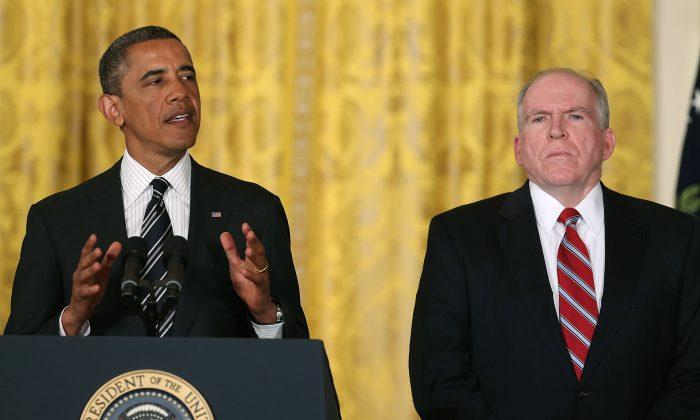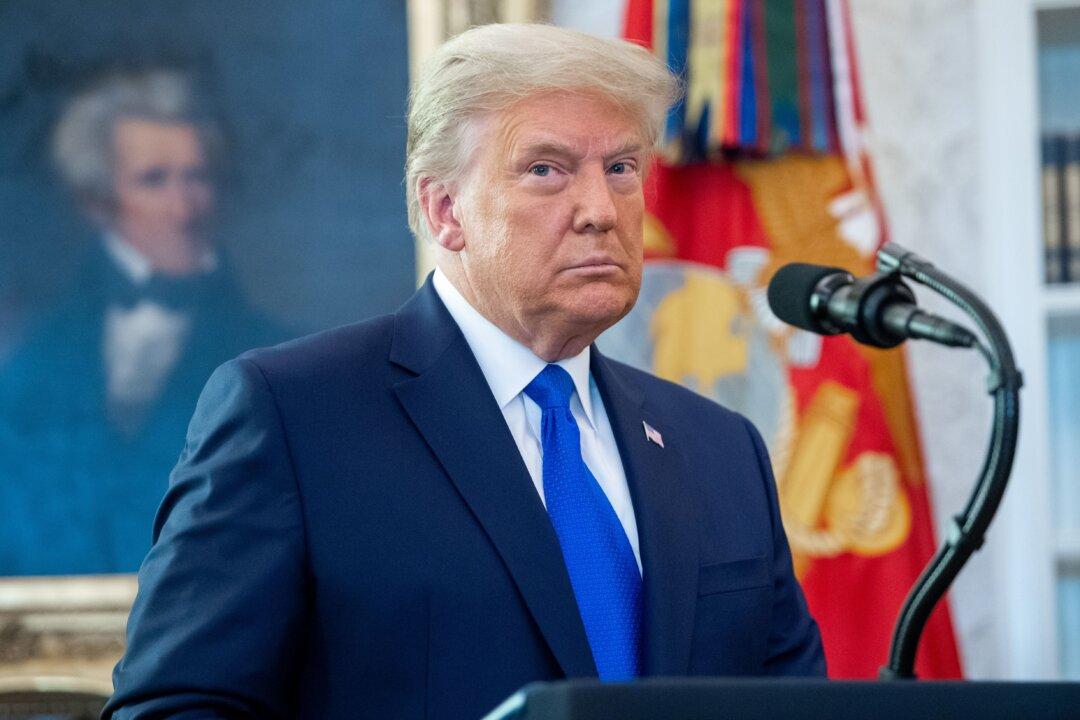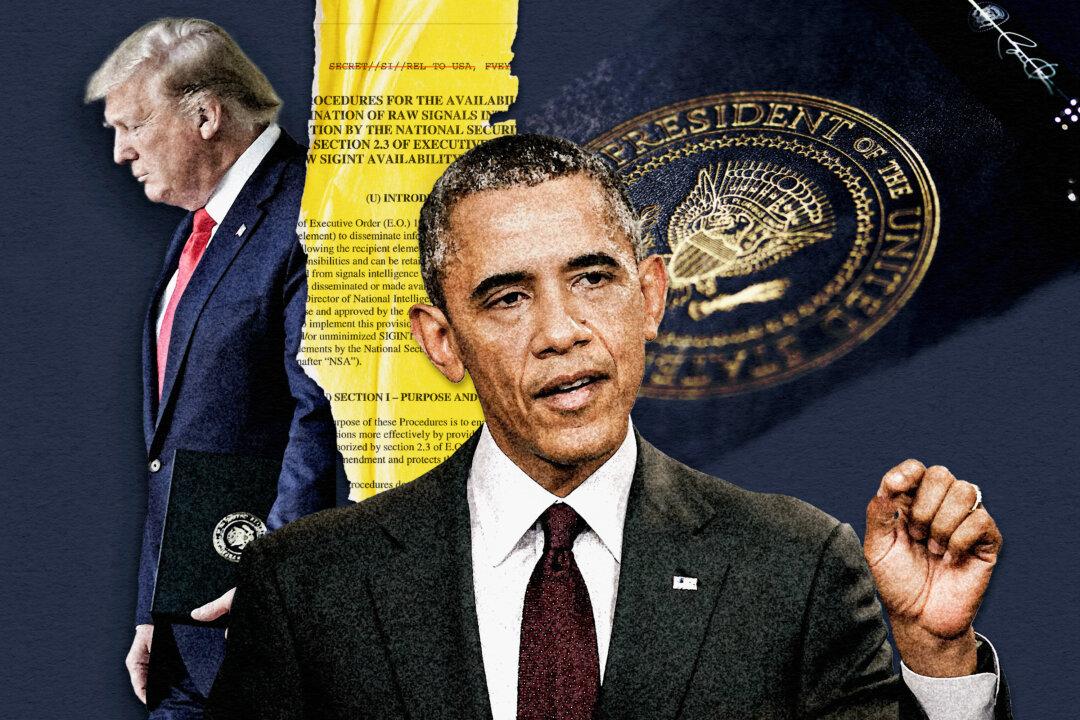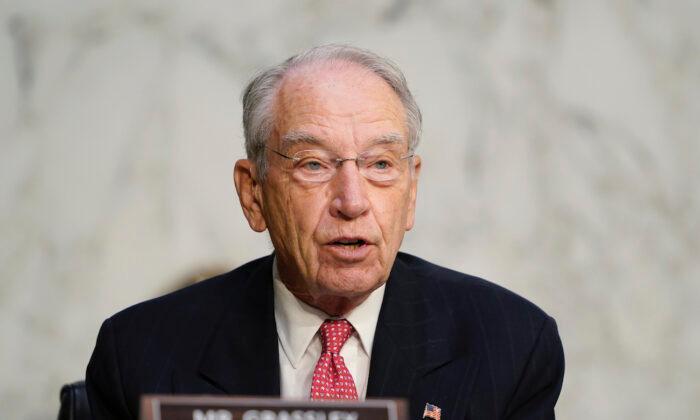More than 2 1/2 years after President Donald Trump assumed office, focus on actions taken during the 2016 presidential campaign is starting to shift toward the CIA and its former director, John Brennan.
While some observers, including this publication, have pointed out for more than a year that Brennan appears to have played a key role in the scandal that’s become known as Spygate, actions taken by Brennan and the CIA now appear to have become a central focus of investigators.
Senate Judiciary Committee Chairman Lindsey Graham (R-S.C.)
told Fox News’ Maria Bartiromo that Justice Department Inspector General (IG) Michael Horowitz was “doing a very in-depth dive about the FISA warrant application” and “the behavior regarding the counterintelligence operation.”
Graham
noted that he believed Horowitz’s report would be coming out in “weeks—not days, not months” and would prove to be “ugly and damning regarding the Department of Justice’s handling of the Russian probe.” Graham noted that the IG’s report has been delayed because “every time you turn around, you find something new.”
Graham said he wants the IG’s report to be as declassified as possible in order for the “American public to hear the story.”
Graham said that prosecutor John Durham “will be looking at criminality, did somebody violate the law,” while Horowitz “will be telling us about the good, the bad, and the ugly, and what should be done internally.” He went so far as to mention exploring a possible restructuring of the Department of Justice.
Toward the end of the
segment, Bartiromo asked Graham: “Who do you think is the mastermind of this? Whose idea was it to insert Donald Trump into Russia meddling?”
Graham responded: “You know, I really am very curious about the role the CIA played here. We know that the FISA warrant application was based on a dossier prepared by Christopher Steele, who was biased against Trump, that was unverified. That’s one problem. But this whole intelligence operation—what role did the CIA play?”
Graham then went a step further, asking: “Who knew about this in the White House? Here’s a question: Was President Obama briefed on the fact that they were opening up a counterintelligence investigation against the Trump campaign? I’d like to know that.”
Bartiromo, who noted that Brennan was running the CIA at that time and would have likely provided the Obama briefing, asked Graham if he was going to call Brennan to testify before Congress. Graham responded somewhat cryptically, saying only, “We’ll see.”
Brennan’s Role
Brennan appears to have played a key role in
establishing the FBI’s counterintelligence investigation into the Trump campaign—including making repeated use of questionable foreign intelligence.
Former Director of National Intelligence James Clapper personally confirmed foreign intelligence involvement during
congressional testimony in May 2017:
Sen. Dianne Feinstein: “Over the spring of 2016, multiple European allies passed on additional information to the United States about contacts between the Trump campaign and Russians. Is this accurate?”
James Clapper: “Yes, it is, and it’s also quite sensitive. The specifics are quite sensitive.”
Brennan has
testified to Congress that any information, specifically “anything involving the individuals involved in the Trump campaign was shared with the bureau [FBI].” Brennan also admitted that it was his intelligence that helped
establish the FBI investigation:
“I was aware of intelligence and information about contacts between Russian officials and U.S. persons that raised concerns in my mind about whether or not those individuals were cooperating with the Russians, either in a witting or unwitting fashion, and it served as the basis for the FBI investigation to determine whether such collusion [or] cooperation occurred.”
Focus on Intelligence Role Prior to FBI Probe
John Solomon of The Hill, who has extensively covered the Spygate scandal, told Bartiromo in an
interview that he was hearing that “John Durham and Bill Barr are focused on the part before the FBI officially got started on July 31, 2016, the period of March to July, and whether intelligence assets—Western, private, or U.S.—were deployed in an earlier effort to start probing the Trump campaign and its Russia ties—maybe lay the breadcrumb trail of evidence that Christopher Steele then collected up and gave to the FBI.”
Solomon noted that when Attorney General Barr said, “I believe there was political surveillance going on,” this was likely what he was referring to.
This focus on the spring of 2016 is particularly interesting given that during this time, Brennan appeared to have employed the use of
reverse targeting on members of the Trump campaign. Reverse targeting refers to the targeting of a foreign individual with the intent of capturing data on a U.S. citizen. During an
Aug. 17, 2018, interview with MSNBC’s Rachel Maddow, Brennan said:
“We call it incidental collection in terms of CIA’s foreign intelligence collection authorities. Any time we would incidentally collect information on a U.S. person, we would hand that over to the FBI because they have the legal authority to do it. We would not pursue that type of investigative, you know, sort of leads. We would give it to the FBI. So, we were picking things up that was of great relevance to the FBI, and we wanted to make sure that they were there—so they could piece it together with whatever they were collecting domestically here.”
As this foreign intelligence—unofficial in nature and outside of traditional channels—was gathered on members of the Trump campaign, Brennan began his process of feeding his gathered intelligence to the FBI. Repeated transfers of foreign intelligence from the CIA director helped push the FBI toward establishing a formal counterintelligence investigation.
Role of Joseph Mifsud
Solomon also discussed the role of Joseph Mifsud, the individual who told Trump campaign aide George Papadopoulos in March 2016 that Russia had Hillary Clinton emails. Solomon noted that he had recently interviewed Stefan Roe, Mifsud’s lawyer, who told him that Mifsud “had long worked with Western intelligence” and that he was “asked to connect George Papadopoulos to Russia—meaning it was an operation, some form of an intelligence operation.”As Solomon noted, this would mean that the “flashpoint that started the whole investigation was, in fact, manufactured from the beginning.” Solomon also noted that “both John Durham and two different committees in Congress have recently reached out to get this evidence from the lawyer, which includes an audiotaped deposition that Mr. Mifsud gave his lawyer before he went into hiding.”
Bartiromo
closed by asking Solomon the same question she put to Graham, “Who do you think is the mastermind?” Solomon responded in a similar fashion to Graham, noting: “I think the CIA. We have to take a closer look at them. We’re starting to see some sign of it.”
Role of UK Intelligence
Luke Harding, a journalist for The Guardian, had
previously reported on the early involvement of UK intelligence and their interaction with the U.S. intelligence community, noting that Britain’s Government Communications Headquarters (GCHQ) was engaged in collecting information on the Trump campaign and transmitting it to the United States beginning in late 2015:
“In late 2015, the British eavesdropping agency GCHQ was carrying out standard ‘collection’ against Moscow targets. ... The intelligence was handed to the U.S. as part of a routine sharing of information,” Harding wrote in an article on Nov. 15, 2017.
Additionally, in the summer of 2016, Robert Hannigan, then-head of GCHQ, traveled to Washington to personally
meet with Brennan:
“That summer, GCHQ’s then head, Robert Hannigan, flew to the U.S. to personally brief CIA chief John Brennan. The matter was deemed so important that it was handled at ‘director level,’ face-to-face between the two agency chiefs,” Harding reported.
Around the same time, Brennan
formed an inter-agency task force comprising an estimated six agencies and government departments. Brennan appeared to describe the task force formation
during the Aug. 17, 2018, interview with MSNBC’s Maddow:
Maddow: ”So, it’s an intelligence-sharing operation between ...”
Brennan: ”
Right. We put together a Fusion Center at CIA that brought NSA and FBI officers together with CIA to make sure that those proverbial dots would be connected.”FBI’s ‘Mid-Year Exam’ Team Shifts to Trump Probe
By the spring of 2016, the Clinton email investigation was winding down. This was due in large part to the fact that the Department of Justice, under Attorney General Loretta Lynch, had decided to set an
unusually high threshold for the prosecution of Clinton, effectively ensuring from the outset that she wouldn’t be charged.
In order for Clinton to be prosecuted, the department required the FBI to establish evidence of intent—even though the gross negligence statute explicitly doesn’t require that.
It was at this same time that Trump campaign adviser Papadopoulos had his April 26, 2016,
meeting with Mifsud, followed a few weeks later with his
ill-fated meeting with Australian diplomat Alexander Downer in May. The meeting with Downer, then Australia’s high commissioner to the UK, was
established through a chain of two intermediaries.
Downer’s conversation with Papadopoulos was reportedly disclosed to the FBI on July 22, 2016, through Australian government channels, although it also may have come directly from Downer himself via the U.S. Embassy in London. Details from the conversation between Downer and Papadopoulos were then used by the FBI to open its counterintelligence investigation of the Trump campaign on July 31, 2016.
Interestingly, the information allegedly relayed by Papadopoulos during the Downer meeting—that the Russians had damaging information on Clinton—appears nearly identical to claims later contained in the first memo from former MI6 spy and dossier author Christopher Steele that the FBI obtained in early July 2016.
Steele’s
first dossier document, dated June 20, 2016, noted that “a dossier of compromising information on Hillary Clinton has been collated by the Russian Intelligence Services over many years.”
Which raises a good question, recently
posed by internet researcher Nick Weil on Twitter: “When the FBI got the tip from Alexander Downer that the Russians had Hillary’s 33k emails, the appropriate action would have been to re-open Mid Year Exam, no?”
Rather than deciding to re-examine the “Mid-Year Exam” investigation, which looked into Clinton’s handling of her emails and use of a private server, the FBI instead used this information to establish an investigation into the Trump campaign.
What makes this sequence of events even more telling is exactly when the FBI first received information from Steele.
After Steele’s company was hired by Fusion GPS in June 2016, he began to reach out to the FBI through Michael Gaeta, an FBI agent and
assistant legal attaché at the U.S. Embassy in Rome whom Steele had worked with on the FIFA case. Gaeta also headed up the FBI’s Eurasian Organized Crime unit, which specializes in investigating criminal groups from Georgia, Russia, and Ukraine.
Gaeta would later be identified as Steele’s FBI handler, in a July 16, 2018, congressional testimony before the House Judiciary and Oversight committees by FBI lawyer Lisa Page.
Following a
reported initial meeting that took place during late June 2016 in Rome, Gaeta
traveled to London on July 5, 2016, and met with Steele at the offices of Steele’s firm, Orbis. During the July 5 meeting, Steele provided the first memo in his dossier to Gaeta for ultimate transmission back to the FBI and the State Department.
At the exact time that Gaeta was meeting with Steele, on July 5, 2016, then-FBI Director James Comey announced the closure of the FBI’s investigation into Clinton’s use of a personal e-mail system during her time as secretary of state.
During the July 5, 2016,
press conference, Comey recommended that Clinton not be charged, stating, “We cannot find a case that would support bringing criminal charges on these facts.” Comey also noted that “although the Department of Justice makes final decisions on matters like this, we are expressing to Justice our view that no charges are appropriate in this case.”
With the July 5 closure of the Clinton investigation, many of the same FBI agents who had worked on the case were assigned to the agency’s July 31, 2016, counterintelligence investigation of the Trump campaign—the opening of which was based on little more than details from the conversation between Downer and Papadopoulos, provided by the Australian government. Although all investigative focus fell on the Trump campaign, the fact that Downer said that the Russians had Clinton’s emails appears not to have been an impetus for the FBI to reopen the Clinton email investigation.
CIA’s Use of Unofficial Intel on Trump Campaign
Rep. Devin Nunes (R-Calif.), who has seen the electronic communication that was used to officially open the FBI’s counterintelligence investigation, has
publicly stated, “We now know that there was no official intelligence that was used to start this investigation.”
Contrast Nunes’s statement with what Brennan
testified before Congress on May 23, 2017:
“I encountered and am aware of information and intelligence that revealed contacts and interactions between Russian officials and U.S. persons involved in the Trump campaign. ... I know that there was a sufficient basis of information and intelligence that required further investigation by the bureau to determine whether or not U.S. persons were actively conspiring, colluding with Russian officials.”
Brennan has
claimed that he didn’t see the dossier until “later in that year; I think it was in December [2016].” Brennan also stated in his testimony that the CIA didn’t rely on the Steele dossier and that it “was not in any way used as a basis for the intelligence community assessment that was done.”
But this claim was countered during the July 16, 2018,
testimony of former FBI lawyer Page, when the following discussion took place regarding Brennan’s August 2016 briefing of then-Sen. Harry Reid:
Rep. Mark Meadows: “We have documents that would suggest that in that briefing the dossier was mentioned to Harry Reid and then, obviously, we’re going to have to have conversations. Does that surprise you that Director Brennan would be aware of [the dossier]?”
Lisa Page: “Yes, sir. Because with all due honesty, if Director Brennan - so we got that information from our source, right? The FBI got this information from our source. If the CIA had another source of that information, I am neither aware of that nor did the CIA provide it to us if they did.”
While some within the FBI likely had parts of the dossier in early July, Page testified that the counterintelligence investigative team didn’t receive it until mid-September—likely during a trip to Rome, where they met with Steele:
Rep. Meadows: “So what you’re saying is, is that you had no knowledge of these potential unverified memos prior to the middle part of September in your investigation?”
Page: “That is correct, sir.”Was Reid’s Letter Based on Steele Dossier Info?
In the days following Brennan’s briefing, Reid
sent a letter on Aug. 27, 2016, to Comey demanding an investigation—and that the investigation be made public. Based on Brennan’s briefing, it’s highly likely that Reid knew an FBI investigation was already underway. Some of the details contained within Reid’s letter relate to former Trump adviser Carter Page and match details contained only within the Steele dossier at the time.
Specifically, Reid claimed that Page had “conflicts of interest due to investments in Russia energy conglomerate Gazprom” and that he had “met with high-ranking sanctioned individuals while in Moscow in July of 2016, well after Trump became the presumptive Republican nominee.”
Page’s investment in Gazprom was known prior to Reid’s letter, but it appears that the first public allegations that Page had met with “high-ranking sanctioned individuals while in Moscow” weren’t made until Yahoo News reporter Michael Isikoff published his article “
U.S. intel officials probe ties between Trump adviser and Kremlin“ on Sept. 23, 2016, based on information directly from Christopher Steele.
Prior to Isikoff’s September article, the only place that information had been referenced, aside from Reid’s letter, was in a July 19, 2016,
Steele dossier memo (there is also a mention in a sequentially earlier, but undated memo from Steele). The Steele dossier wouldn’t become public until its Jan. 10, 2017,
publication by BuzzFeed.
During his May 2017 testimony, Brennan discussed his briefings to the Gang of Eight. Brennan testified that the briefings were done “in consultation with the White House” and stated that he gave the “same briefing to each of the Gang of Eight members.” Notably, Brennan conducted his briefings individually over a period of almost a full month between Aug. 11, 2016, and Sept. 6, 2016.
However, Nunes has stated that he wasn’t given the same briefing as was Reid, despite that Nunes held the position of chairman of the House Intelligence Committee at the time. Nunes made this disclosure in a July 28, 2019,
interview with Bartiromo, noting: “We now know that John Brennan briefed Harry Reid on the dossier in August 2016. At the same time, he never briefed me or Paul Ryan, who was the speaker of the House at the time.”
Brennan’s Role in Official Reports
The last major segment of Brennan’s efforts involved a series of three reports. The
first report was released on Oct. 7, 2016, and the
second on Dec. 29, 2016.
This final report was used to continue pushing the Russia-collusion narrative following the election of Trump as president. Notably, Adm. Mike Rogers, then director of the National Security Agency, publicly dissented from the findings of the ICA, assigning it only a moderate confidence level.
As previously noted, while Brennan has denied using the dossier in the ICA, he did attach a two-page summary of the dossier to the intelligence community assessment that he, along with Clapper and Comey, delivered to President Barack Obama on Jan. 6, 2017.
Comey then met with President-elect Trump to inform him of the dossier. This meeting took place just hours after Comey, Brennan, and Clapper formally briefed Obama on both the ICA and the Steele dossier.
Comey would only inform Trump of the “salacious” details contained within the dossier. He later
explained on CNN in an April 2018 interview that he'd done so at the request of Clapper and Brennan, “because that was the part that the leaders of the intelligence community agreed he needed to be told about.”
Shortly after Comey’s meeting with Trump, both the Trump–Comey meeting and the existence of the dossier were leaked to CNN by James Clapper.
The House Intelligence Committee report on Russian election interference
confirmed that Clapper personally leaked confirmation of the dossier, along with Comey’s meeting with Trump, to CNN:
“Clapper’s discussion with Tapper took place in early January 2017, around the time IC leaders briefed President Obama and President-elect Trump, on ‘the Christopher Steele information,’ a two-page summary of which was ‘enclosed in’ the highly-classified version of the ICA.”
Immediately following the CNN story,
BuzzFeed published the Steele dossier, and the Trump–Russia conspiracy was pushed into the mainstream.







